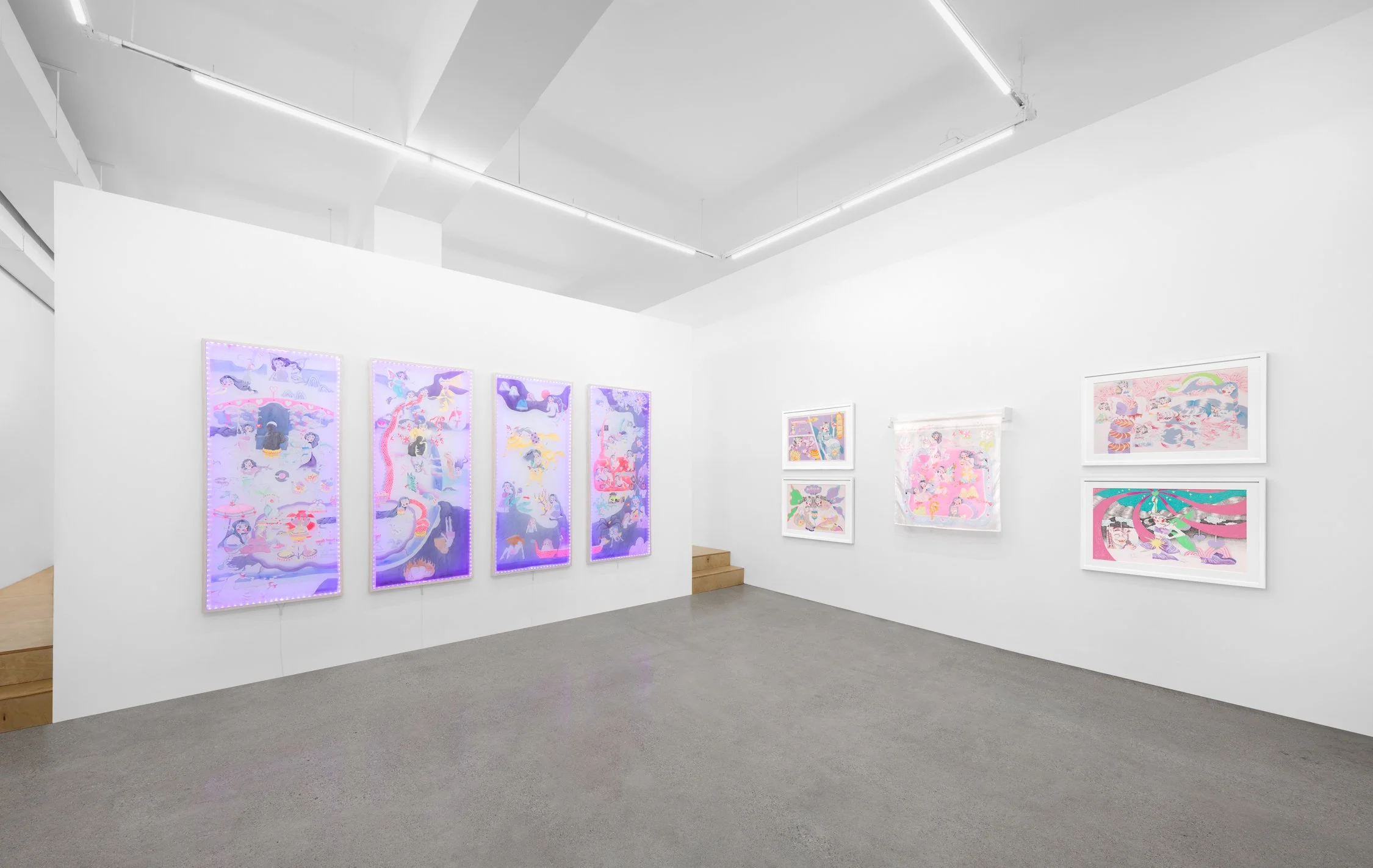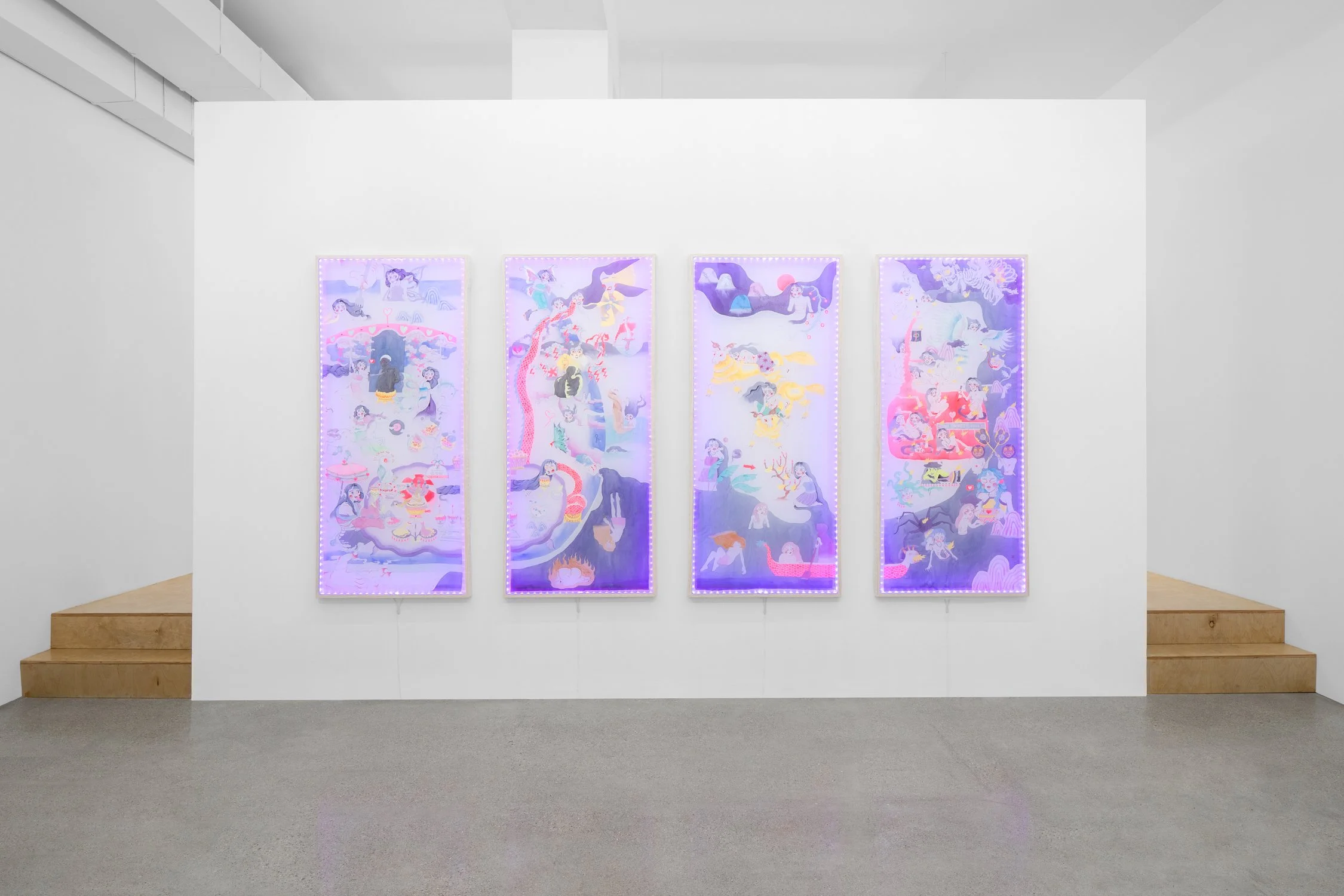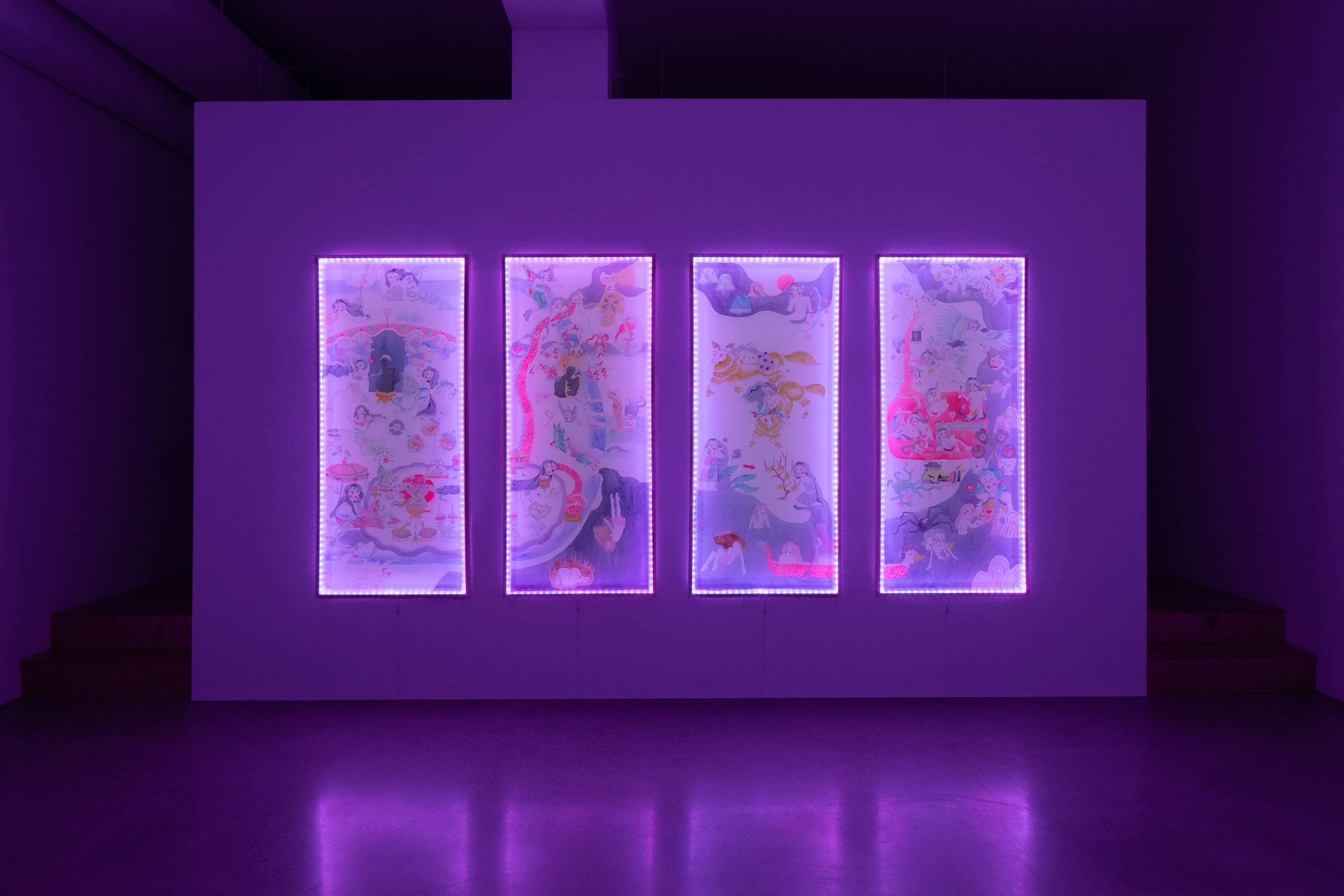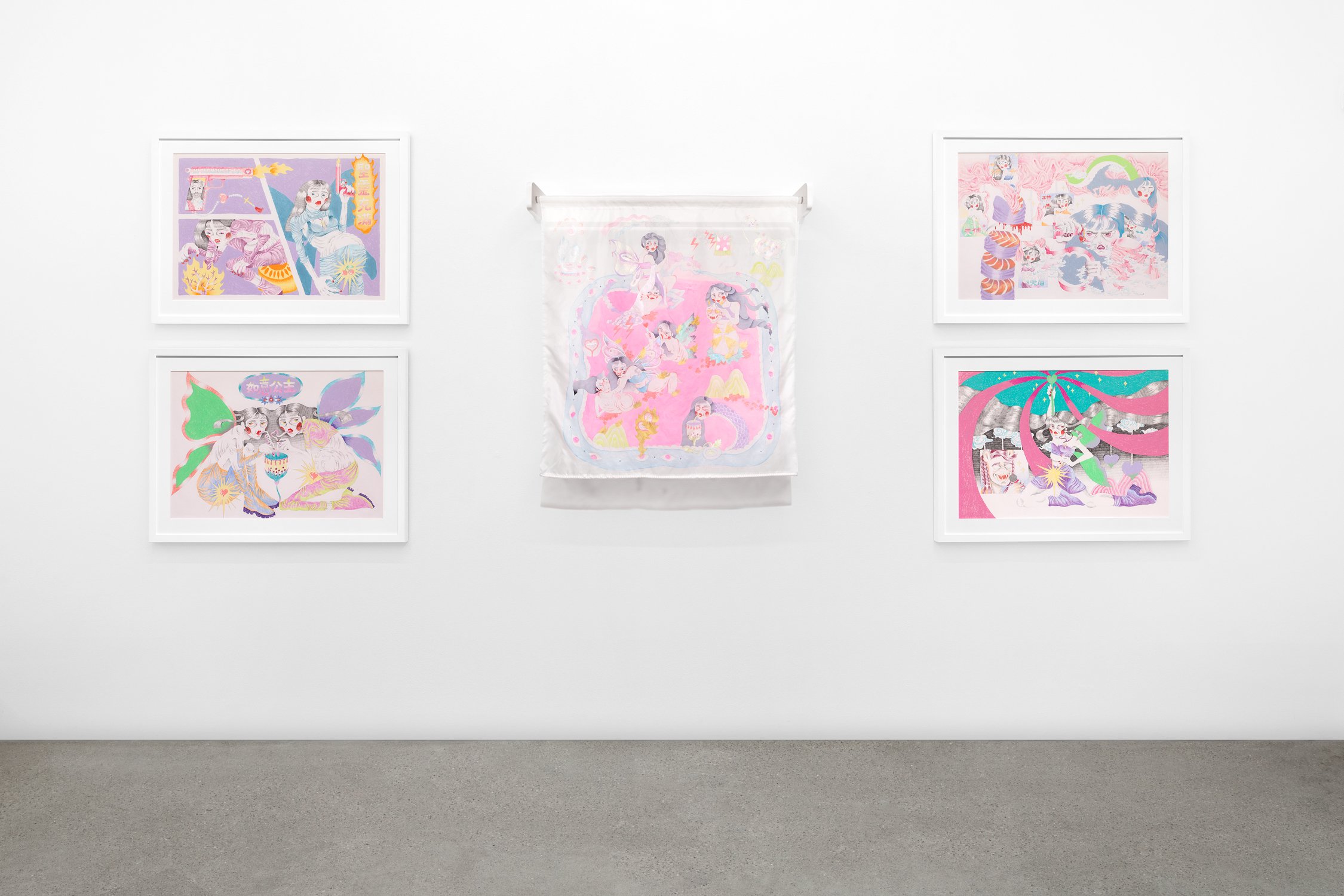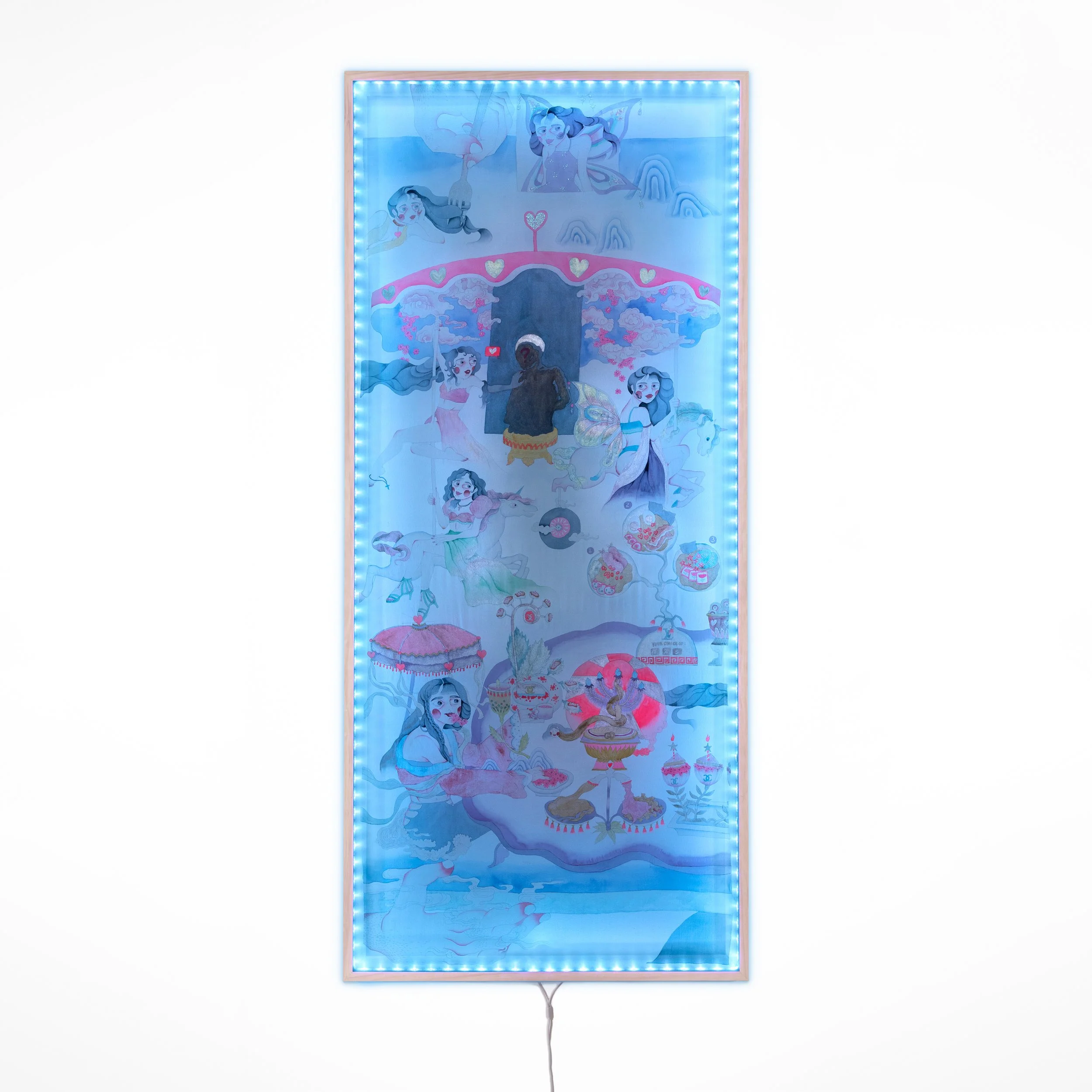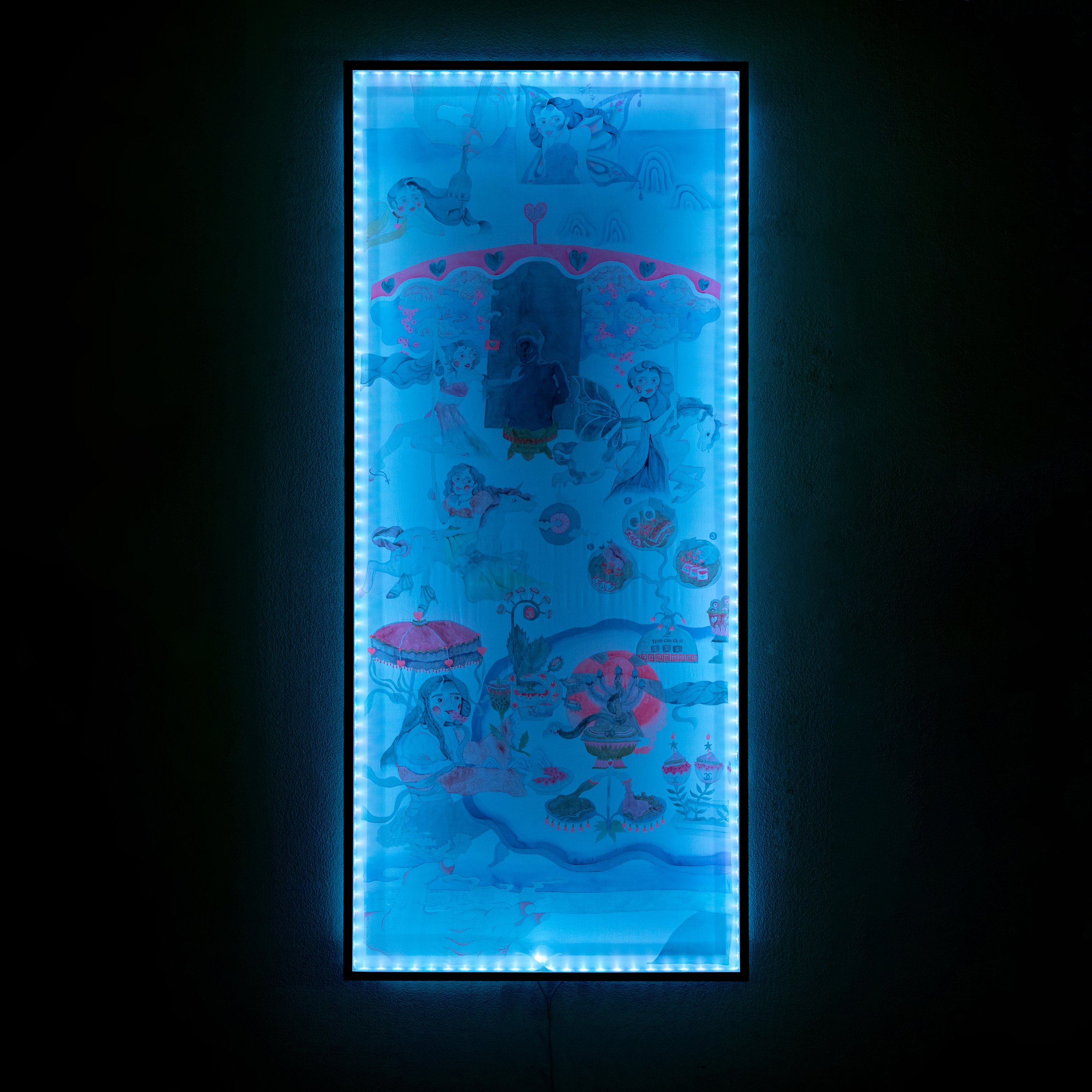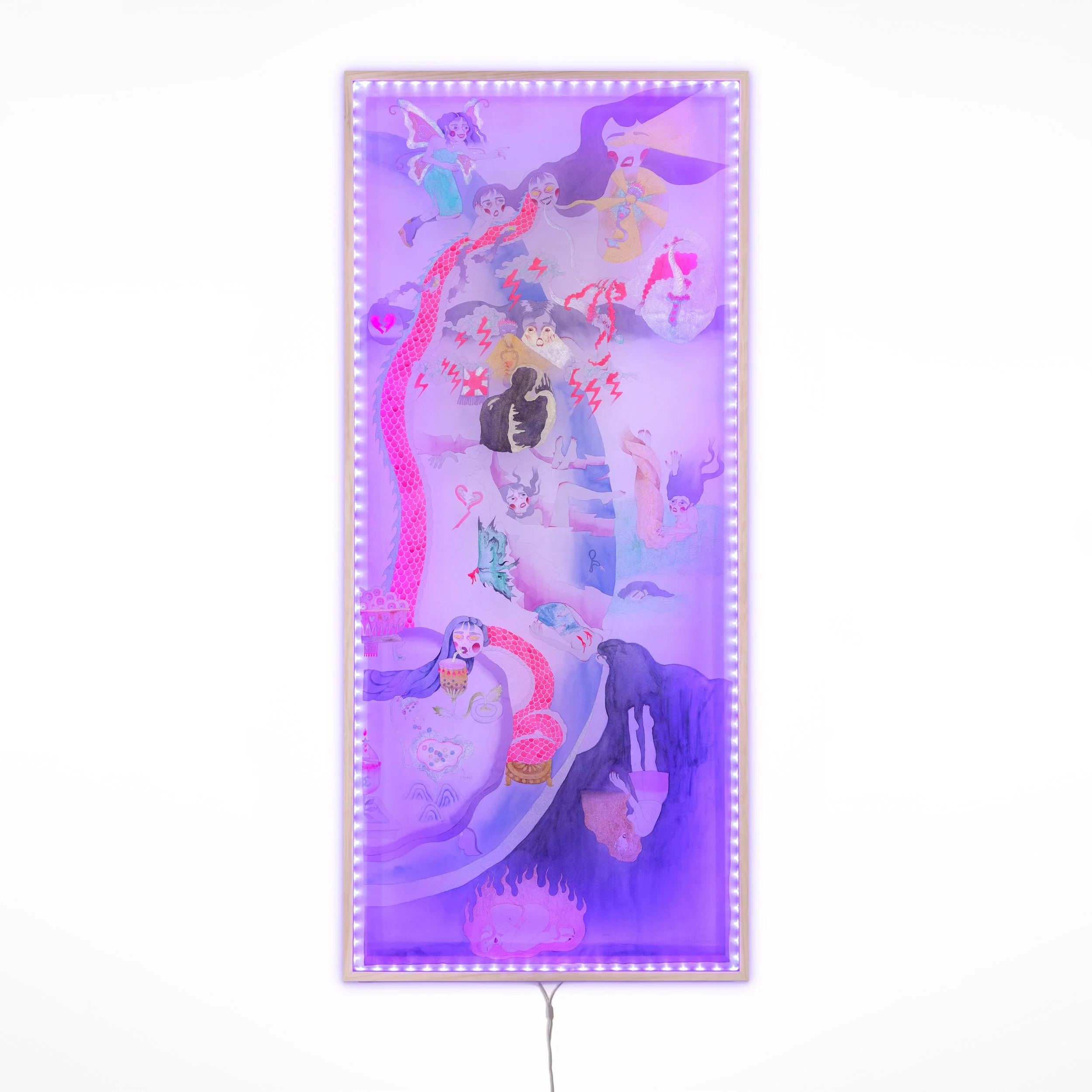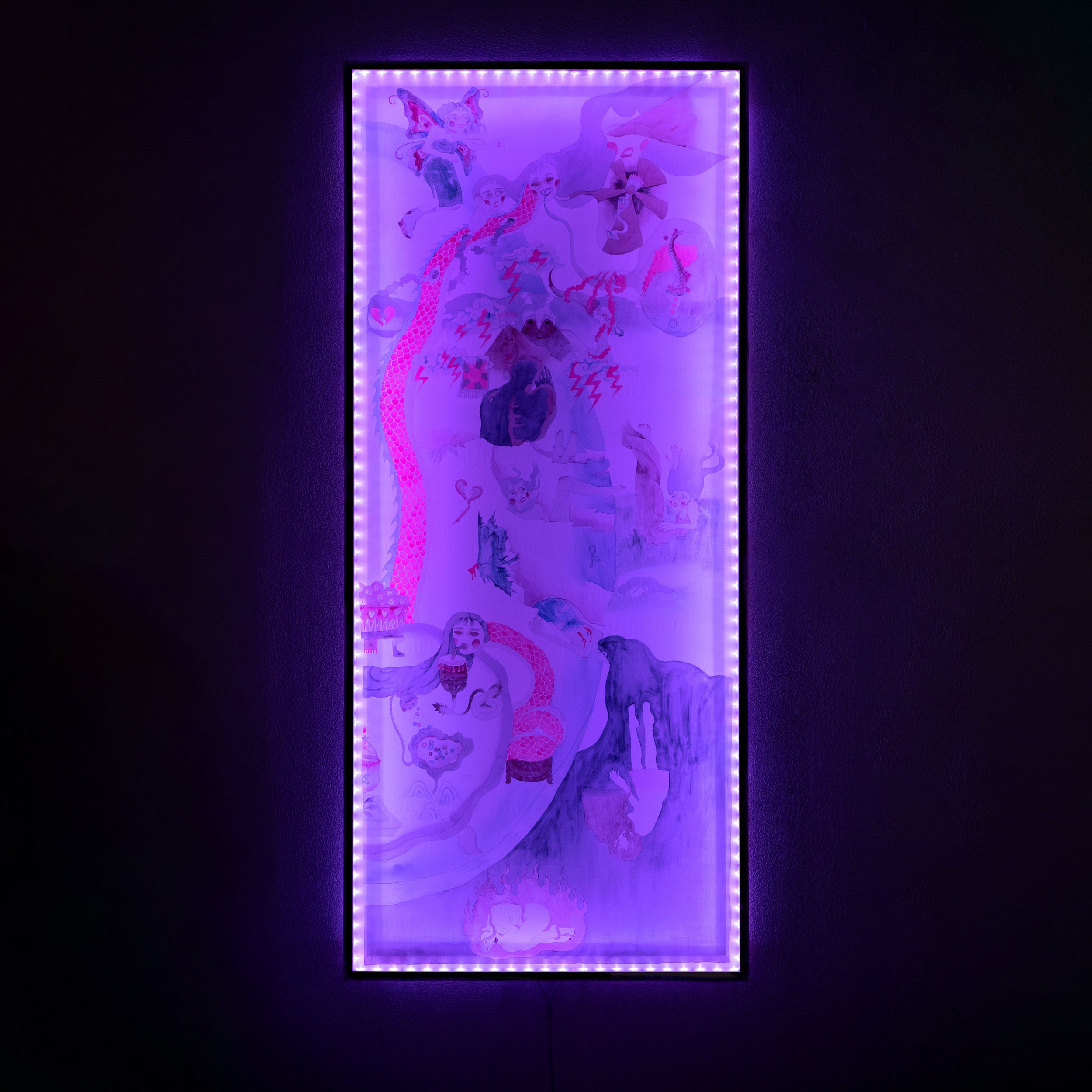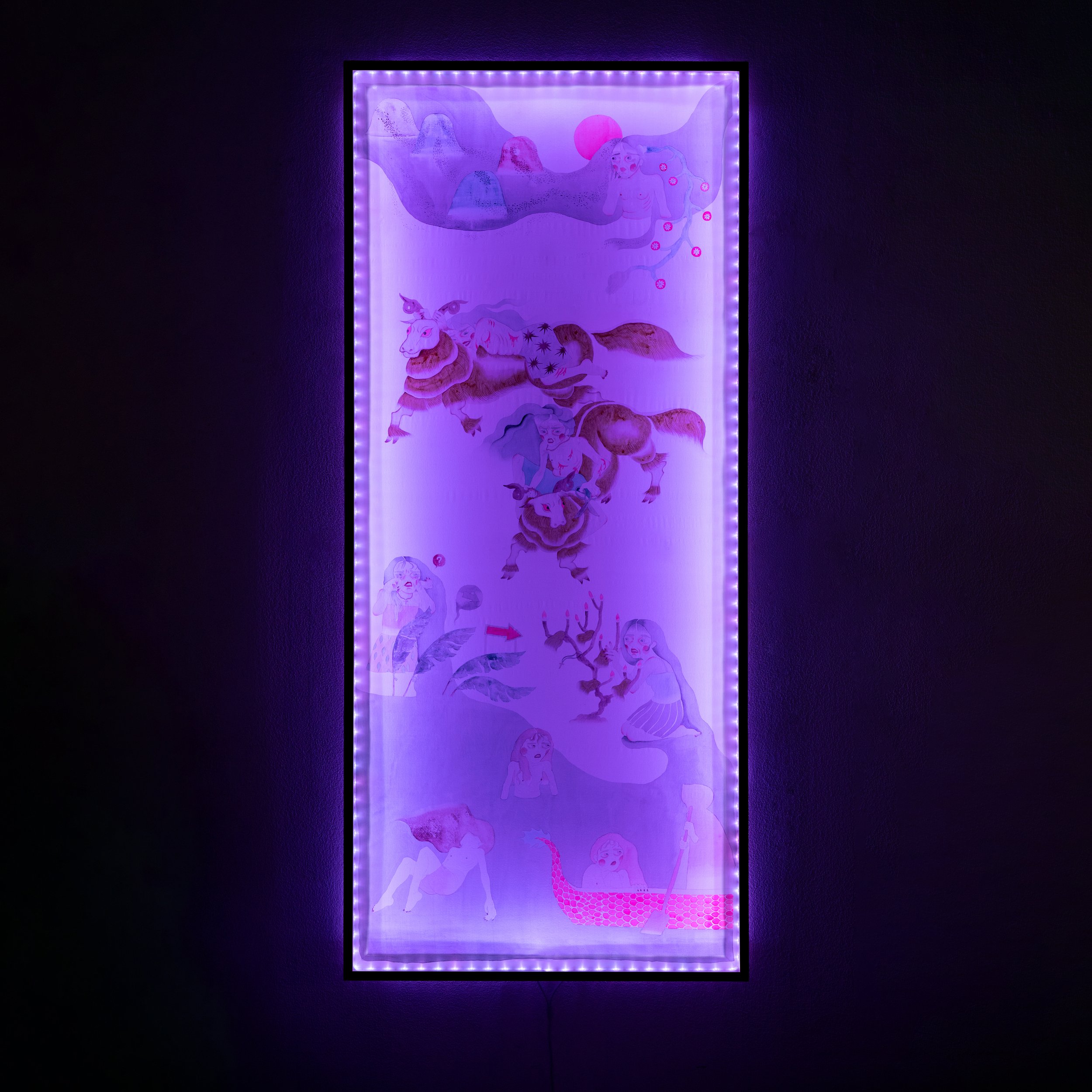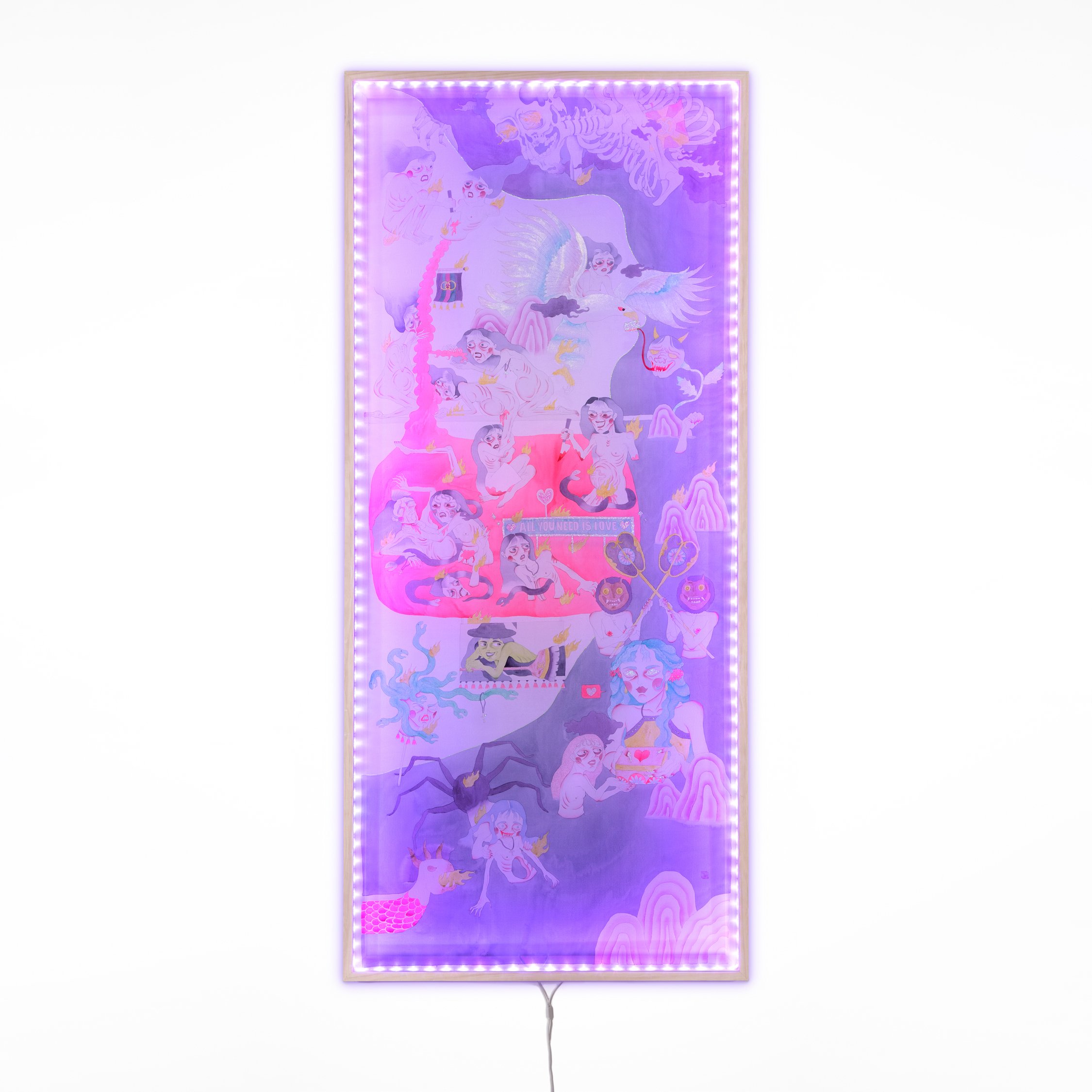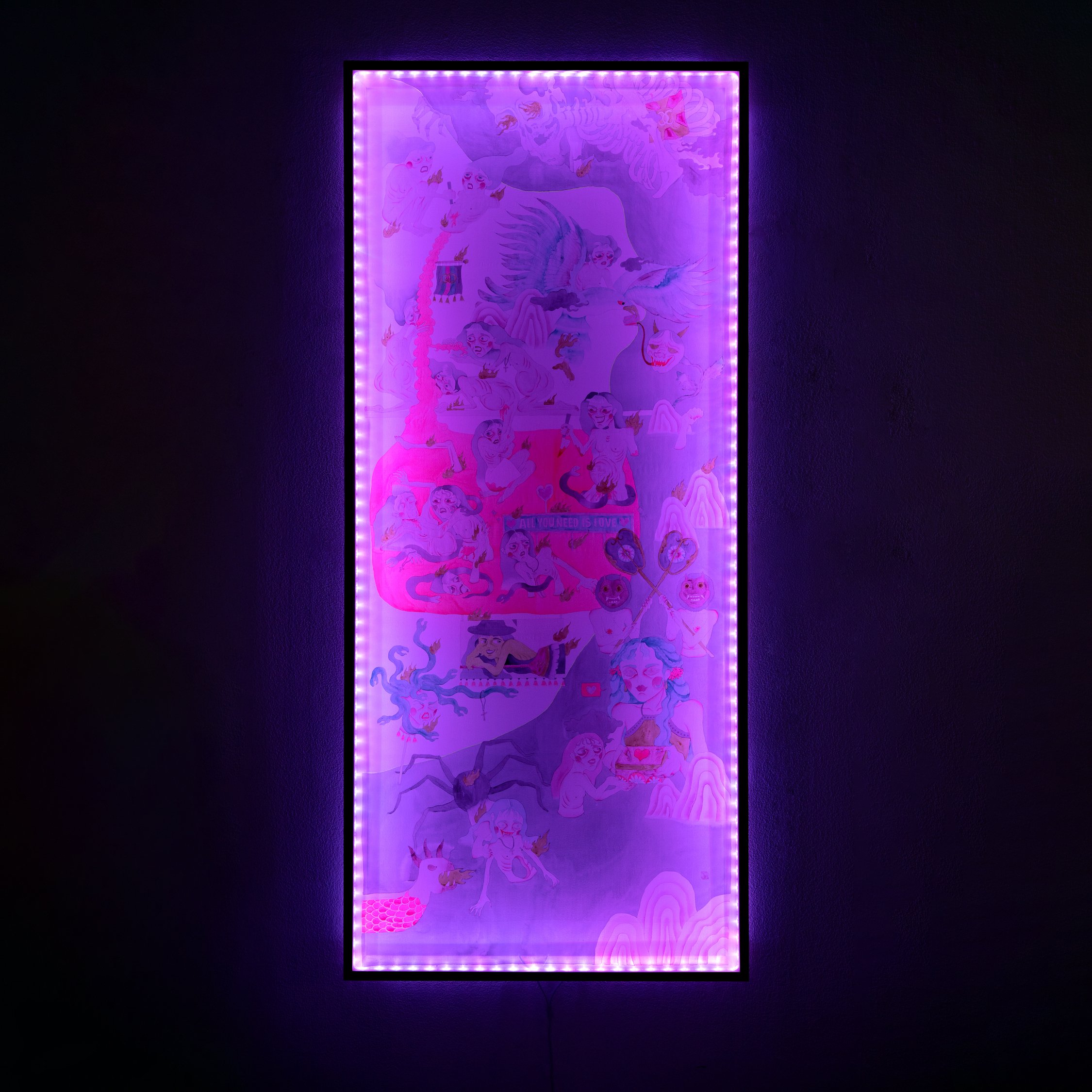Louis Buhl & Co. is pleased to present a solo exhibition with Taiwan and Detroit-based artist G.E. Liu, titled First Love Paradise. Liu’s multiform works are rooted in ancient Chinese alchemy and Jung’s concept of the hero’s journey toward individuation. Her visual vocabulary explores the commonalities and variations between the East and West and infuses humor, sexuality, and self-deprecation. Liu is fascinated by the body-spirit cultivation of Medieval Chinese science and cosmology and sees herself as something of an alchemist as she mixes and contrasts ideas around mythology, gender, love, theology, and cultural identity.
Liu develops female characters to act as heroines, villains, and innocents as they traverse her densely layered narratives. More often than not, these characters are the mortal receivers of lessons from the gods, objects of their affections, and at times, even subjects of their deceit. The series of four silk paintings that comprise the gallery’s main wall are inspired by the book SHE: Understanding Feminine Psychology by Robert A. Johnson, in which he relates feminine psychology to the Greek myth of Eros and Psyche to analyze the universal woman’s journey to self-discovery. The story, in essence, follows the romantic relationship between the pair; it begins in Eros’s paradise, where Psyche exists happily with the love and affection she has always longed for despite being blind to Eros’s true identity—according to Eros, the two may only be together if this determinant is forever concealed. As the tale progresses, Psyche, driven by pressure and curiosity, unveils his identity, the telling discovery activating her societal awakening, and the betrayal felt by Eros forcing her entrance into the realm of hell, a space that is defined by heartbreak and other challenges she must overcome to win Eros back.
The silk paintings echo Northern Renaissance painter Hieronymus Bosch’s famous work “The Garden of Earthly Delights,” which is a humorous, macabre and absurdist depiction of the ‘benefits and hazards’ of marriage through the lens of biblical storytelling. The triptych presents Adam and Eve in a harmonious landscape on the left panel, a hedonistic paradise in the center, and a blazing hellscape awaiting them on the right. Although in the case of Liu’s work, paradise (or heaven) and hell are not viewed in the traditional sense of “good” and “bad,” but rather the opposite. Using the ancient myth and Johnson’s analysis of it as an agent to touch on preeminent collective themes, Liu draws reference to the patriarchal society in which women exist, and, generally speaking, the little-to-no awareness that they have of this accustomed reality. A paradise defined by ignorance and oblivion is anything but the true meaning of the word. On the other hand, Liu suggests that adversity—in the case of Psyche, the horrible trials she faces in hell—is not only necessary but beneficial for women to endure in life, as such trials allow for maturity, individuation, and the development of complete agency. It is the experience of suffering and misfortune that fuel consciousness and, in result, eternal fulfillment.
The adjacent gallery wall displays an additional silk painting complimented by four drawings that place a concentrated focus on the female figures in examination. Many of them defined by butterfly wings associated with Psyche’s undeniable beauty and large bellies characteristic of hungry ghosts, the women embody a marriage between heaven and hell. They exemplify the heroine who has withstood the evolution of maturing; she is aware, in control, and, most importantly, she thrives off of the recognition that progression in life is impossible without contraries. Here, Liu stresses the interconnectedness and interdependence between two opposites. This idea relates to Liu’s practice at large, which is driven by her seamless threading of contradictions in a myriad of forms; for example, the combination of ancient and contemporary visual languages, the employment of cheerful colors to explore dark topics, the foundational use of silk, a material that is simultaneously prestigious and kitsch, and the fusion of Eastern and Western cultures.
Illustrating an array of visual and conceptual components, Liu unites them through the exhibition’s title. All encompassing, First Love Paradise attests to the experience of falling in love, and a life lesson that involves both destruction and rebirth. The good and the bad are classified together under one “paradise;” As Liu explains, “a hell is worth celebrating, just like a paradise is worth questioning.”
G.E Liu: First Love Paradise is on view from May 14 through June 22, 2022.
Featured Artwork
G.E. Liu — Journey of the First Love Paradise #1, 2022
Gouache, watercolor and glitter on silk.
Artwork: 71h x 31.9375w inches
G.E. Liu — Journey of the First Love Paradise #2, 2022
Gouache, watercolor and glitter on silk.
Artwork: 71h x 31.9375w inches
G.E. Liu — Journey of the First Love Paradise #3, 2022
Gouache, watercolor and glitter on silk.
Artwork: 71h x 31.9375w inches
G.E. Liu — Journey of the First Love Paradise #4, 2022
Gouache, watercolor and glitter on silk.
Artwork: 71h x 31.9375w inches
G.E. Liu — Princesses as They Wish, 2022
Graphite, pastel and colored pencil on paper. Framed in white.
Artwork: 21.4h x 31.1w inches
Framed: 27.5h x 36.875 inches
G.E. Liu — In the Name of Love, 2022
Graphite, pastel and colored pencil on paper. Framed in white.
Artwork: 21.4h x 31.1w inches
Framed: 27.5h x 36.875 inches
G.E. Liu — I’d Kill Him with a Sushi Knife, 2022
Graphite, pastel and colored pencil on paper. Framed in white.
Artwork: 21.4h x 31.1 inches
Framed: 27.5h x 36.875 inches
G.E. Liu — Filled with Holy Spirit, 2022
Graphite, pastel and colored pencil on paper. Framed in white.
Artwork: 21.4h x 31.1w inches
Framed: 27.5h x 36.875 inches
G.E. Liu — Hungry Ghost Psyche Girls, 2022
Gouache, watercolor, beads and glitter on silk and acrylic bar.
Artwork: 39h x 36w inches

